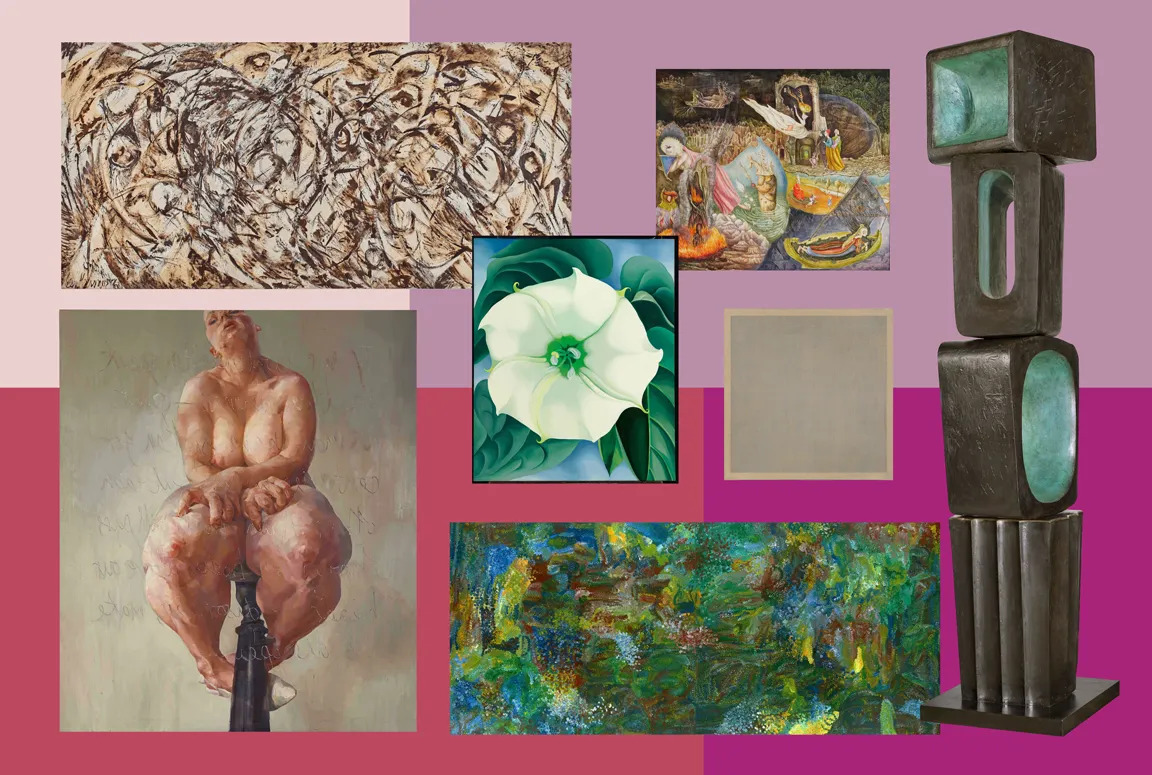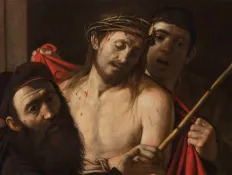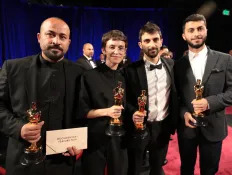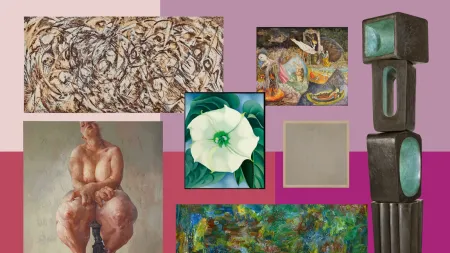
When Salvator Mundi, a painting attributed to Leonardo da Vinci, fetched $450 million at Christie’s in 2017, it became the most expensive artwork ever sold. While male artists, dead or alive, keep breaking records at auctions (Jeff Koons’s $58.4 million Balloon Dog sculpture in 2013, Claude Monet’s $65.5 million Nymphéas painting in 2024, etc.), the past decade or so has shown a new appreciation for their female counterparts. Some have set personal records, including Joan Mitchell, whose centennial is being celebrated in 2025. Last May, Sotheby’s auctioned four of her paintings. Noon (ca. 1969), the priciest, hit $22.6 million—impressive, but not enough to top the $29.1 million fetched by her 1959 Untitled in 2023, the highest price ever paid for an abstract painting by a female artist.
Below are 13 women artists whose works have crossed the million-dollar threshold.
Read more of our Women’s History Month coverage here.
-
Lee Bontecou
In 1959 Lee Bontecou (b. 1931) started creating wall-mounted sculptures made of welded steel frames, recycled canvases, and industrial materials such as conveyor belts, mail sacks, and wires. These collagelike compositions recall the horrors of World War II, which deeply affected Bontecou and her artistic practice. “I was angry . . . . All of those—all the ones with the teeth—it was a thing of what that war was,” she said in a 2009 interview with Dore Ashton for the Archives of American Art. Untitled (1959–60)—resembling, in MoMA’s words, “something between a stained glass window and a patchwork quilt,” is a rare example of this emotional body of work to have come to auction. It fetched $9.1 million at Christie’s in November 2021.
-
Cecily Brown

Image Credit: Digital image copyright © Sotheby’s. Artwork copyright © 2025 Cecily Brown. British painter Cecily Brown (b. 1969), who is best known for large-scale canvases deftly blending abstraction and figuration, started rising in the art world in the 1990s, before she turned 30. She is championed by powerful market players, including Charles Saatchi and Larry Gagosian, the Guggenheim Museum, the Whitney, the Metropolitan, and the National Gallery, and her paintings regularly sell for seven-figure sums. In 2018 Sotheby’s New York sold Suddenly Last Summer (1999) for $6.8 million, which remains Brown’s record. “The painting is just a knockout,” says David Galperin, senior vice president and head of evening sales for contemporary art at Sotheby’s in New York, alluding to the admirable “shift in color and texture” in Brown’s work.
-
Leonora Carrington

Image Credit: Digital image copyright © Sotheby’s. Artwork copyright © 2025 Estate of Leonora Carrington/Artists Rights Society (ARS), New York. Featuring hybrid creatures—part human, part animal, part plant—engaging in mysterious rituals, Les Distractions de Dagobert was painted in 1945, at the height of Leonora Carrington’s career. With its rich imagery and vibrant palette, this hypnotic painting, where the divine and the terrestrial meet, is one of the most admired works by the British Surrealist (1917–2011). The work’s title is a reference to King Dagobert, a Merovingian monarch who ruled Gaul in the early 17th century, popularly remembered for his sexual deviance and taste for luxury. The painting, carrying an estimate of $12 million to $18 million, sold in 2024 after a 10-minute bidding battle to the Argentine businessman Eduardo Costantini, founder of the Museum of Latin American Art of Buenos Aires, for a record-breaking $28.5 million, the highest ever paid for a Carrington work at the time.
-
Barbara Hepworth

Image Credit: Digital image copyright © Christie’s Images Ltd. Artwork copyright © Bowness. In 1974 Barbara Hepworth (1903–1975), one of the leading figures of modernism, had the Morris Singer foundry cast four copies of her sculpture The Family of Man: Ancestor II. One of them was sold in 2023 for $11.6 millionat Christie’s 20th Century Evening Sale in New York, almost doubling its $6 million high estimate and setting a record for the British sculptor. This approximately eight-foot stack of cubes, each with a different orientation and one of them featuring a large cylindrical hole, is part of “The Family of Man,” a series of nine abstract sculptures representing various stages of life from youth to marriage to parenthood.
-
Emily Kame Kngwarreye

Image Credit: Digital image: Art Leven. Artwork copyright © Emily Kam Kngwarray/Copyright Agency. Licensed by Artists Rights Society (ARS), New York, 2025. Emily Kame Kngwarreye (1910–1966) did not pick up a brush until she was in her 70s and yet became one of the most famous Aboriginal Australian artists in history. After selling for $1,056,000 in 2007, her painting Earth’s Creation 1 broke its own record a decade later reaching $2.1 million at an auction in Sydney. Suspense was at its highest when the server hosting the live event crashed, either because of a cyber attack or because too many people tried to log on simultaneously. The 1994 work, which had been shown at the National Museum of Art in Osaka, the National Museum of Australia, and the National Gallery of Victoria, was bought by Australian art dealer Tim Olsen.
-
Lee Krasner

Image Credit: Digital image copyright ©Sotheby’s. Artwork copyright © 2025 The Pollock-Krasner Foundation/Artists Rights Society (ARS), New York. Lee Krasner (1908–1984) lost her husband, Jackson Pollock, another leading figure of Abstract Expressionism, and her mother in 1956 and 1959, respectively. Her grief served as a catalyst for her “Umber” series of monumental paintings. One of them, The Eye Is the First Circle (1960), got its name from the first line of Ralph Waldo Emerson’s 1841 essay “Circles.” This nearly 16-foot-long oil on canvas with fierce brushstrokes and cream tones was stolen in 1990 from dealer Peter Bonnier by an unknown burglar, located a year later thanks to an anonymous tip, then kept in the collection of Sarah Wittenborn Miller until May 2019, when it fetched $11.6million at Sotheby’s.
-
Agnes Martin

Image Credit: Digital image copyright Sotheby’s. Artwork copyright © Agnes Martin Foundation, New York/Artists Rights Society (ARS), New York. Best known for her subtle grid paintings, which she started making in the 1950s, Agnes Martin (1912–2004) is one of the leading figures of Minimalism. While she identified as part of Abstract Expressionism, she aspired to reinvent the movement. Her intention appears clearly in Grey Stone II (1961), which was the object of a bidding war during the 2023 Emily Fisher Landau Collection sale at Sotheby’s New York. It fetched $16 million, double the presale high estimate of $8 million. Martin turned the rough, flat, geometric qualities of the canvas into a hypnotic experience. “This work is a form of meditation,” said Sotheby’s specialist Courtney Kremers in a promotional video. “An object that represents time and process. All of those things combined are a reflection, quite simply, of life.”
-
Julie Mehretu

Image Credit: Digital image copyright © Sotheby’s. Artwork copyright © Julie Mehretu, courtesy of the artist and Marian. Goodman Gallery. In 2023 two bidders competed over Julie Mehretu’s 2008 Walkers with the Dawn and Morning, a wide architectural drawing covered with a swirl of calligraphic marks. The multilayered work fetched $10.38 million at “The Now Evening Auction” at Sotheby’s in New York, setting a new record for an African-born artist (b. 1970). The geometrical, minimalist, gray-dominated composition was created for an exhibition organized in reaction to the devastation caused by Hurricane Katrina and its impact on New Orleans. Its name is a line from a poem by Langston Hughes, a hymn to resilience, perseverance, and optimism in the face of life’s challenges and adversity.
-
Joan Mitchell

Image Credit: Digital image copyright © Christie’s Images Ltd. 2025. Artwork copyright © Estate of Joan Mitchell. Joan Mitchell (1925–1992) was a pioneering figure in the Abstract Expressionism movement. Her painting Untitled (1959) was the leading highlight in Christie’s 20th Century Evening Sale in 2023 in New York. This seminal work, estimated at $25 million to $35 million—one of the highest auction estimates in history for a female artist at the time—eventually achieved $29.1 million. “Untitled stands as a best-in-class example, declarative of Mitchell’s deep understanding of color and demonstrative of the fearlessness with which she wielded her brush,” says Sara Friedlander, deputy chairman of Post-War and Contemporary Art at Christie’s. In the 1950s, linear elements sometimes referred to as “whiplash strokes” proliferated in Mitchell’s canvases, resulting in kaleidoscopic explosions of color.
-
Cady Noland
American conceptual artist Cady Noland (b. 1956) is famous for highlighting the inconsistencies of the American dream, which she perceives and depicts as a nightmare. For example, Bluewald (1989)is based on the historic picture of Lee Harvey Oswald taken just as he was shot by Jack Ruby. Resembling a rifle-range target, this screenprint on aluminum sold for $9.79 million in 2015 at Christie’s “Looking Forward to the Past” sale, its oversize holes both conjuring up the Pop Art aesthetic and evoking disproportionate violence.
-
Georgia O’Keeffe

Image Credit: Digital image copyright Sotheby’s. Artwork copyright © 2025 Georgia O’Keeffe Museum/Artists Rights Society (ARS), New York. Georgia O’Keeffe (1887–1986) is known mostly for her close-up paintings of flowers, and Jimson Weed/White Flower No. 1 (1932), featuring the white blossom of a weed, is a leading example. The museum founded in her name in Santa Fe, New Mexico, decided to auction this work, which belonged to the artist’s younger sister Anita and later hung in George W. Bush’s private dining room at the White House, so it could acquire new pieces by O’Keeffe. “There are gaps that need to be filled,” said Robert Kret, then at the helm of the museum. Jimson Weed, which had already gone to auction twice before—selling for only $990,000 in 1987 and $1 million in 1994—went for$44.4 million at Sotheby’s in New York in 2014, reaching nearly three times the high estimate of $15 million.
-
Jenny Saville

Image Credit: Digital image copyright Sotheby’s. Artwork © 2025 Artists Rights Society (ARS), New York/DACS, London. Jenny Saville’s Propped (1992), a nude with generous curves and white slippers, depicts the artist (b. 1970) herself, sitting in front of a steamy mirror scribbled with a quote by French feminist Luce Irigaray: “If we keep speaking the same language — the language that men have used for centuries, we will disappoint one another. Once again, words will run through our bodies, our heads — disappear, make us disappear.” The text is reversed, which makes it hard to decipher. After an eight-bidder battle won by an anonymous buyer at Sotheby’s London in 2018, Saville’s self-portrait fetched $12.4 million against an estimate of $3.7 million to $4.9 million. Originally owned by Charles Saatchi, this work was part of a 25-lot single-owner sale of pieces held by management consultant and collector David Teiger, which earned a total of $47 million.
-
Cindy Sherman

Image Credit: Artwork copyright © Cindy Sherman. Digital image courtesy of the artist and Hauser & Wirth. Largely between 1977 to 1980, American photographer Cindy Sherman (b. 1954) created “Untitled Film Stills,” a series of 70 images in which she posed as fictitious characters, from blonde bombshell to lone hitchhiker, shot as if they were stills taken from films. Initially gathered by Ydessa Hendeles, a curator, artist, and former dealer from Toronto, the collection was sold to the industrialist Mitchell P. Rales and his wife, Emily, for Glenstone, the couple’s contemporary art museum in Potomac, Maryland. In 2014 Christie’s put up 21 of these images for auction during its evening sale of postwar and contemporary art in New York. Estimated at $6 million to $9 million, the lot achieved $6.7 million.
Lee Bontecou
In 1959 Lee Bontecou (b. 1931) started creating wall-mounted sculptures made of welded steel frames, recycled canvases, and industrial materials such as conveyor belts, mail sacks, and wires. These collagelike compositions recall the horrors of World War II, which deeply affected Bontecou and her artistic practice. “I was angry . . . . All of those—all the ones with the teeth—it was a thing of what that war was,” she said in a 2009 interview with Dore Ashton for the Archives of American Art. Untitled (1959–60)—resembling, in MoMA’s words, “something between a stained glass window and a patchwork quilt,” is a rare example of this emotional body of work to have come to auction. It fetched $9.1 million at Christie’s in November 2021.
Cecily Brown

British painter Cecily Brown (b. 1969), who is best known for large-scale canvases deftly blending abstraction and figuration, started rising in the art world in the 1990s, before she turned 30. She is championed by powerful market players, including Charles Saatchi and Larry Gagosian, the Guggenheim Museum, the Whitney, the Metropolitan, and the National Gallery, and her paintings regularly sell for seven-figure sums. In 2018 Sotheby’s New York sold Suddenly Last Summer (1999) for $6.8 million, which remains Brown’s record. “The painting is just a knockout,” says David Galperin, senior vice president and head of evening sales for contemporary art at Sotheby’s in New York, alluding to the admirable “shift in color and texture” in Brown’s work.
Leonora Carrington

Featuring hybrid creatures—part human, part animal, part plant—engaging in mysterious rituals, Les Distractions de Dagobert was painted in 1945, at the height of Leonora Carrington’s career. With its rich imagery and vibrant palette, this hypnotic painting, where the divine and the terrestrial meet, is one of the most admired works by the British Surrealist (1917–2011). The work’s title is a reference to King Dagobert, a Merovingian monarch who ruled Gaul in the early 17th century, popularly remembered for his sexual deviance and taste for luxury. The painting, carrying an estimate of $12 million to $18 million, sold in 2024 after a 10-minute bidding battle to the Argentine businessman Eduardo Costantini, founder of the Museum of Latin American Art of Buenos Aires, for a record-breaking $28.5 million, the highest ever paid for a Carrington work at the time.
Barbara Hepworth

In 1974 Barbara Hepworth (1903–1975), one of the leading figures of modernism, had the Morris Singer foundry cast four copies of her sculpture The Family of Man: Ancestor II. One of them was sold in 2023 for $11.6 millionat Christie’s 20th Century Evening Sale in New York, almost doubling its $6 million high estimate and setting a record for the British sculptor. This approximately eight-foot stack of cubes, each with a different orientation and one of them featuring a large cylindrical hole, is part of “The Family of Man,” a series of nine abstract sculptures representing various stages of life from youth to marriage to parenthood.
Emily Kame Kngwarreye

Emily Kame Kngwarreye (1910–1966) did not pick up a brush until she was in her 70s and yet became one of the most famous Aboriginal Australian artists in history. After selling for $1,056,000 in 2007, her painting Earth’s Creation 1 broke its own record a decade later reaching $2.1 million at an auction in Sydney. Suspense was at its highest when the server hosting the live event crashed, either because of a cyber attack or because too many people tried to log on simultaneously. The 1994 work, which had been shown at the National Museum of Art in Osaka, the National Museum of Australia, and the National Gallery of Victoria, was bought by Australian art dealer Tim Olsen.
Lee Krasner

Lee Krasner (1908–1984) lost her husband, Jackson Pollock, another leading figure of Abstract Expressionism, and her mother in 1956 and 1959, respectively. Her grief served as a catalyst for her “Umber” series of monumental paintings. One of them, The Eye Is the First Circle (1960), got its name from the first line of Ralph Waldo Emerson’s 1841 essay “Circles.” This nearly 16-foot-long oil on canvas with fierce brushstrokes and cream tones was stolen in 1990 from dealer Peter Bonnier by an unknown burglar, located a year later thanks to an anonymous tip, then kept in the collection of Sarah Wittenborn Miller until May 2019, when it fetched $11.6million at Sotheby’s.
Agnes Martin

Best known for her subtle grid paintings, which she started making in the 1950s, Agnes Martin (1912–2004) is one of the leading figures of Minimalism. While she identified as part of Abstract Expressionism, she aspired to reinvent the movement. Her intention appears clearly in Grey Stone II (1961), which was the object of a bidding war during the 2023 Emily Fisher Landau Collection sale at Sotheby’s New York. It fetched $16 million, double the presale high estimate of $8 million. Martin turned the rough, flat, geometric qualities of the canvas into a hypnotic experience. “This work is a form of meditation,” said Sotheby’s specialist Courtney Kremers in a promotional video. “An object that represents time and process. All of those things combined are a reflection, quite simply, of life.”
Julie Mehretu

In 2023 two bidders competed over Julie Mehretu’s 2008 Walkers with the Dawn and Morning, a wide architectural drawing covered with a swirl of calligraphic marks. The multilayered work fetched $10.38 million at “The Now Evening Auction” at Sotheby’s in New York, setting a new record for an African-born artist (b. 1970). The geometrical, minimalist, gray-dominated composition was created for an exhibition organized in reaction to the devastation caused by Hurricane Katrina and its impact on New Orleans. Its name is a line from a poem by Langston Hughes, a hymn to resilience, perseverance, and optimism in the face of life’s challenges and adversity.
Joan Mitchell

Joan Mitchell (1925–1992) was a pioneering figure in the Abstract Expressionism movement. Her painting Untitled (1959) was the leading highlight in Christie’s 20th Century Evening Sale in 2023 in New York. This seminal work, estimated at $25 million to $35 million—one of the highest auction estimates in history for a female artist at the time—eventually achieved $29.1 million. “Untitled stands as a best-in-class example, declarative of Mitchell’s deep understanding of color and demonstrative of the fearlessness with which she wielded her brush,” says Sara Friedlander, deputy chairman of Post-War and Contemporary Art at Christie’s. In the 1950s, linear elements sometimes referred to as “whiplash strokes” proliferated in Mitchell’s canvases, resulting in kaleidoscopic explosions of color.
Cady Noland
American conceptual artist Cady Noland (b. 1956) is famous for highlighting the inconsistencies of the American dream, which she perceives and depicts as a nightmare. For example, Bluewald (1989)is based on the historic picture of Lee Harvey Oswald taken just as he was shot by Jack Ruby. Resembling a rifle-range target, this screenprint on aluminum sold for $9.79 million in 2015 at Christie’s “Looking Forward to the Past” sale, its oversize holes both conjuring up the Pop Art aesthetic and evoking disproportionate violence.
Georgia O’Keeffe

Georgia O’Keeffe (1887–1986) is known mostly for her close-up paintings of flowers, and Jimson Weed/White Flower No. 1 (1932), featuring the white blossom of a weed, is a leading example. The museum founded in her name in Santa Fe, New Mexico, decided to auction this work, which belonged to the artist’s younger sister Anita and later hung in George W. Bush’s private dining room at the White House, so it could acquire new pieces by O’Keeffe. “There are gaps that need to be filled,” said Robert Kret, then at the helm of the museum. Jimson Weed, which had already gone to auction twice before—selling for only $990,000 in 1987 and $1 million in 1994—went for$44.4 million at Sotheby’s in New York in 2014, reaching nearly three times the high estimate of $15 million.
Jenny Saville

Jenny Saville’s Propped (1992), a nude with generous curves and white slippers, depicts the artist (b. 1970) herself, sitting in front of a steamy mirror scribbled with a quote by French feminist Luce Irigaray: “If we keep speaking the same language — the language that men have used for centuries, we will disappoint one another. Once again, words will run through our bodies, our heads — disappear, make us disappear.” The text is reversed, which makes it hard to decipher. After an eight-bidder battle won by an anonymous buyer at Sotheby’s London in 2018, Saville’s self-portrait fetched $12.4 million against an estimate of $3.7 million to $4.9 million. Originally owned by Charles Saatchi, this work was part of a 25-lot single-owner sale of pieces held by management consultant and collector David Teiger, which earned a total of $47 million.
Cindy Sherman

Largely between 1977 to 1980, American photographer Cindy Sherman (b. 1954) created “Untitled Film Stills,” a series of 70 images in which she posed as fictitious characters, from blonde bombshell to lone hitchhiker, shot as if they were stills taken from films. Initially gathered by Ydessa Hendeles, a curator, artist, and former dealer from Toronto, the collection was sold to the industrialist Mitchell P. Rales and his wife, Emily, for Glenstone, the couple’s contemporary art museum in Potomac, Maryland. In 2014 Christie’s put up 21 of these images for auction during its evening sale of postwar and contemporary art in New York. Estimated at $6 million to $9 million, the lot achieved $6.7 million.

A Spanish Art Dealer Sold a ‘Lost’ Caravaggio. Police Are Now Investigating Her for Fraud.

Oscar-winning Director Sharmeen Obaid-Chinoy on Her New Documentary, ‘Diane von Furstenberg: Woman in Charge’

X-Chair X-Tech office chair review: Ultra premium, ultra expensive

Blitzer Near Deal to Sell Real Salt Lake, Royals to Miller Family


